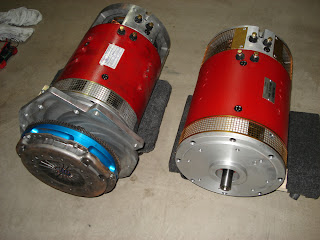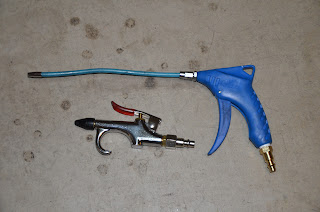Some of you may be distantly aware that March 2nd marked the Z3's second year on the road. Unfortunately, as you know, it's not actually on the road at this time. It has once again, fallen victim to a motor problem. Of the 12 month span starting last March until now, the car has been on the road for only 6 1/2 of those months. Not all that time was to repair motor problems. Last July, August and beginning of September was spent adding the MasterFlux AC system and getting the car ready for EVCCON. Never the less, it has has not been as trouble free as I would have liked. But I remain optimistic that those types of problems may soon be behind me and I'll be in for some extended trouble free motoring.
So let's move on with what's been happening the past couple weeks. To catch everyone up to date that hasn't read the last couple posts, the car developed a leak to ground. That means that I could measure the high voltage on the frame of the car. That poses a few problems, one being the threat of being shocked, another being the threat of arcing and potential fire under the right circumstances, and last, the charger wouldn't stay on. The charger is grounded to the chassis of the car, so when it sensed the high voltage on the chassis, it simply shuts itself off for protection.
I'd methodically tracked the problem down to the motor, finding that there was a leak from the terminals where the high voltage is sent into the motor, to the case itself. This is not supposed to happen, but it can if there's been a build up of dust inside the motor caused by the wear of the brushes. Most recommend blowing out the motor out with compressed air, which I did, repeatedly. In the mean time, I contacted George Hamstra from Netgain to find out if there was a preferred method for cleaning the motor more thoroughly. Compressed air is pretty much it. He reasoned that I must have brushes in the car that are better suited for racing and tend to dust quite a bit. So he took it upon himself to send me, at his expense!, a set of $320 replacement brushes. Not just any brushes, mind you, but Helwig split top brushes, pretty much the best money can buy.

The top two brushes are tied together on one connecting wire. That is one of the older sets. Presumably, they were the same size as the new Helwig brush at the bottom, but look how much they've worn after only 9,000 miles. Notice too how the old brush closest to the new one is shorter than the top brush. Curiously, this was the case with each pair. The brush that was in the bracket closest to the front of the motor was warn by as much as 1/8th of an inch more than the back brush. I don't know if that means anything, but it certainly happened.
I've mentioned that George is tired of seeing me suffer through problems with the motor. He also offered at that time to simply replace the motor, but I asked him to hold off to see if more cleaning and the new brushes made a difference. The new brushes arrived on the 1st of March, but I didn't get a chance to work on the car until the 4th. I was able to pull 3 sets of the old brushes out with no difficulty. But on the 4th set, I was able to get one brush out OK, but the space was so tight and constrained, I simply could not get the last brush out. After laboring over it for a few hours, and coming to terms with it for another the next 24 hours, I finally came to the decision that I was going to have to pull the motor and transmission out of the car. Believe me, that was something I did NOT want to do.
My dad was kind enough to come over and help me out. It took us about 4 hours, but we got everything unhooked, the motor free and then we were able to drop it out of the car. I've lent my lift to a friend, so I didn't have that, but it's OK, because this time I was determined to drop the motor out instead of lift it out. with the cunning use of the floor jack, several 2x4s, levers and muscle power, we were able to do it. That gave me access to the last brush, and I carefully pulled it out. It was at that point that I looked at the brush I just pulled and saw something truly astounding. Take a look:

Yes, what you see there are 3 holes drilled into the top of the brush, and a chunk of the brush missing! Where it went, I have no idea. I looked around everywhere, but could not find the piece or pieces of carbon laying about. As it was the last brush I pulled, it should have come out with the brush, but it didn't. It got me wondering if perhaps it had come off and become wedged somewhere inside the motor, causing the short. It seems unlikely, but I have no way of knowing without disassembling the motor.
With the brushes out, I took the opportunity to blow more air through the motor. A lot more air. The air gun I had been using works fine, but the nozzle is fixed and short. I bought an air gun with an 8" flexible nozzle that I was able to carefully insert into the motor and spray in harder to reach areas.
I sprayed compressed air until I saw, or could smell no more dust. Believe it or not, that dust has a funny smell (even though I was wearing a mask). I put the new brushes back in carefully, and took another reading with the Ohm meter. To my astonishment, the leak was actually a bit worse. I hooked up a 12v battery to the motor with a switch in line so that I could run the motor for a bit and try blowing more air while the motor was moving. Had to be careful not to stick the nozzle anywhere in the motor or near the brush assembly. 4 or 5 more tanks of air and no dust coming out. At this point, the motor is as dust free as I can get it without taking it apart.
After all that, the leak persists. At it's worse I measured the resistance between the S1 terminal and the case at 508 Ohms. That's enough to pass 320 milliamps. Again, not a lot, but certainly enough to feel, and enough to render the charger useless.
I contacted George with the story, telling him the results of my efforts, and sending him the picture of the brush. At this point I'm faced with either taking the motor apart and trying to clean it further, or getting a new one. George was absolutely dumbfounded when he saw that picture. He said that it looked like someone had tried to make a Brush Wear Indicator, but he couldn't figure out why they drilled three holes, or worse yet, why they left that brush in the motor. He was pissed, and justifiably so. He's paid to have this motor repaired twice and the second time he told them to pay particular attention to it so that it was done to the highest standard possible. Clearly, that didn't happen.
Fed up with the whole thing, George is sending me a new motor. I must say, that I have very mixed feelings about this. On one hand, I'm thrilled to be getting a motor that will hopefully have none of the flaws that have plagued this motor from it's first day. On the other hand, it just eats me up that this whole fiasco has cost George so much. Shipping to Illinois and back, twice, two rebuilds of the motor, and finally a whole new motor plus the shipping for that from Illinois. Dreadful! I had hoped to be one George's success stories.
While all of this is going on, I am planning a couple minor enhancements. I bought a voltage meter/display from Lightobject that can be programmed to cut a relay at a specific voltage. I'm thinking that I'd like to add that to the car as a safety backup in case the charger doesn't cut off in time. If this device sees the voltage rise to the level I've defined, it would trigger a relay that would simply cut power to the charger, protecting the batteries. Stay tuned.




